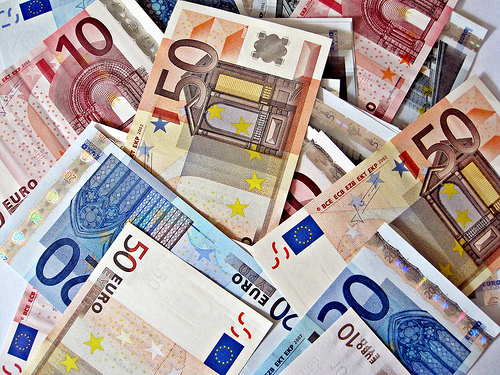
TTIP or TTTF? Why the Transatlantic Trade and Investment Partnership will most likely become a trade treaty too far

In
TTIP has become the new trade game for the EU institutions. The players seem however to have neglected an important fact. Since the ratification of the Marrakech Agreements in 1994, all big trade treaties have failed. This applies to the Doha Development Round of course, but also to the OECD Multilateral Agreement on Investment (MAI), and the Anti-Counterfeiting Trade Agreement (ACTA).A serious trade strategy should be less grand-standing and more concrete. This however does not look probable.
(Photo credit: Images of money, Flickr))
*****
TTIP OR TTTF? WHY THE TRANSATLANTIC TRADE AND INVESTMENT PARTNERSHIP WILL MOST LIKELY BECOME A TRADE TREATY TOO FAR
A new – but classic – trade parade has begun. The EU political and business leaders have recommenced their traditional chorus with gusto. A new trade agreement, the Transatlantic Trade and Investment Partnership (TTIP) is rising on the horizon. It will boost international transactions, develop competitiveness, enhance innovation, and even possibly keep all of us young, healthy and happy. But will it really? A serious costs/benefits assessment indicates the contrary.
On the one hand, the benefits will be limited. Trade liberalization is more effective when it is intersectoral than intrasectoral. Trade exchanges between the United States and the EU clearly belong mostly to the second category. Both markets are already very open. Foreign direct investment is high, and legal protection of investment quite strong. The impact of additional openness will thus be moderate, especially compared with the present huge monetary fluctuations between the US and EU currencies. Some proponents also invoke some geopolitical benefits but those are not economic and thus cannot be quantified.
On the other hand, the real costs of the TTIP may have been cruelly underestimated.
Firstly, the EU economy remains weak. Unemployment is high. The rise of inequalities is rampant. In many Member States, this is not the ideal economic environment for ratifying a new fundamental trade treaty. Moreover, the ratification itself will be a complex process. The TTIP doesn’t just cover exclusively EU competences, but also shared competences. Consequently it will need to be ratified in all Member States.
Secondly, populism is on the rise in some Member States due to the financial crisis, the acceleration of globalization and the development of immigration. Any transfer of sovereignty is increasingly contested. This is hardly the ideal political environment for ratifying a fundamental trade treaty. Moreover, as the EU is largely in charge of the negotiation process, this could even increase its present growing unpopularity.
Thirdly, some negotiation topics are extremely polarizing between the United States and the EU countries. This concerns – among other issues – agricultural subsidies, food standards, intellectual property protection, television programmes, education and health services, financial regulation and the fight to protect private data. It is difficult to imagine that the agreement will be concluded without precise commitments in these areas.
Furthermore, the TTIP could generate new tensions in the EU. The single market has been built on a subtle balance between mutual recognition and harmonization. Mutual recognition, established since the famous 1979 Cassis de Dijon judgement, is compensated by the harmonization of some rules which cannot be left to each Member State. This forbids the strategy of free riders and the establishment of excessively low national standards. As harmonization will be impossible between the United States and the EU, the TTIP will in fact destabilize the overall balance between mutual recognition and harmonization in the single market.
Last but not least, the establishment of a judicial protection system for investors is already provoking a lot of bad blood. The example of Vattenfall asking for billions of euros from the German authorities after their decision to abandon nuclear energy is frequently cited. The multiplication of such judicial procedures runs the risk of generating intense criticisms. The introduction of provisions about investor–state dispute settlement (ISDS) in such a broad framework will certainly not be easy.
Big trade treaties tend not to be popular nowadays. Since the entry into force of the Marrakech Agreement of 1994, little has actually been achieved. The negotiations of the Doha Development Round are stalling. Let’s also remember the unproductive negotiations for the OECD Multilateral Agreement on Investment (MAI). They failed. Let’s remember the negotiations for the Anti-Counterfeiting Trade Agreement (ACTA). They also failed. The negotiations for the TTIP run a high risk of suffering exactly the same fate.
Much energy could be invested for very little result, and this could ultimately not improve, but destabilize the transatlantic relationship. Furthermore, even if it succeeds, other problems will arise. The United States has other projects, such as the Trans-Pacific Partnership (TPP) or the Regional Comprehensive Economic Partnership (RCEP). These have the potential to create a really inextricable spaghetti bowl of preferential agreements, which could also become a spaghetti bowl of various regulatory standards.
There are other ways to deepen trade cooperation between the United States and the EU. That would mean dividing up the most contentious issues mentioned above and trying to deal separately with each of them. This approach would be technically complex, time consuming, and would offer few photo-ops. It would not allow grandstanding speeches. On the other hand, it would quieten the public’s fears. And it could offer something that the Doha Round, MAI and ACTA did not offer: success. Even if that success does not materialize, this approach will not have required too much energy, too much time, or too much bad geopolitical blood. Ad augusta per angusta.
Charles Secondat
The copyright of this commentary belongs to the Egmont Institute. It can be quoted or republished freely, as long as the original source is mentioned.?